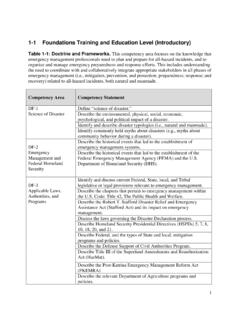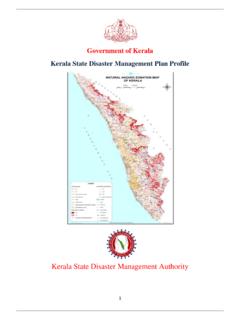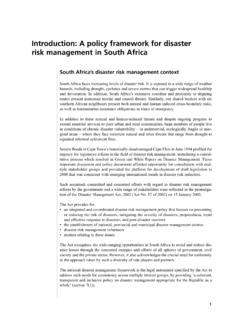Transcription of Background - BMTPC
1 With its vast territory territory,, large population and unique geogeo--climatic conditions, Indian sub sub--continent is exposed to natural catastro catastro-- phes traditionally Even today the natural hazards like floods, cyclones, droughts and earthquakes are not rare or unusual phenomenon in the While the vulnerability varies from region to region, a large part of the country is exposed to such natural hazards which often turn into disasters causing signifi- cant disruption of socio socio--economic life of communities leading to loss of life and property Concerned with the impact of natu- ral disasters in the Background of the United Nations' resolu- tion, and realising that the preparedness and prevention are integral components of the development process.
2 The Govern- ments at the Central and State levels are gradually evolving strategies policies and programmes for natural disaster mitiga- tions, preparedness and prevention. In the process modernisation is fast taking place in fields like forecasting forecasting,, satellite and re re-- mote sensing sensing,, computerised systems of vulnerability and risk Background assessment and other technologies for warning and monitor monitor-- ing In response to UN General Assembly R esolution declaring Resolution 1990-2000 as International Decade for Natural disaster R Ree- Apropos the Yokohama Strat- duction, the Government of India has taken several initiatives egy for Safer World in 1994.
3 For strengthening disaster reduction strategies including prepa- the erstwhile Ministry of Urban ration of V ulnerability Atlas of India Vulnerability Development, Government of India (1994) had constituted an Expert Group to study the following issues related to im- pact of natural hazards par- ticularly with respect to hous- ing and infrastructure. i. Need to identify vulnerable areas with reference to natural hazards such as earthquakes, cyclones, floods, etc. etc.,, having a potential of damaging housing stock and related infrastructure ii.
4 P reparation of a Vulnerability Atlas showing areas vulnerable to natural disasters and determination of risk levels of houses. iii. Formulation of a strategy for setting up TTechno echno echno-- legal regimes for enforcing disaster resistant construction and planning practices in natural hazard prone human settlements. Hazard Vulnerability in India Indian Subcontinent: among the world's most disaster prone areas 59% of land vulnerable to Earthquakes of land vulnerable to Cyclones 5% of land vulnerable to Floods > 1 million houses damaged annually + human, social, other losses Earthquakes land is liable to severe earthquakes (intensity MSK IX or more).
5 Land is liable to MSK VIII (similar to Latur / Uttarkashi). land is liable to MSK VII (similar to Jabalpur quake). Biggest quakes in: Andamans, Kuchchh, Himachal, Kashmir, and the North East Wind and Cyclones 1877-2005: 283 cyclones (106 severe) in a 50 km wide strip on the East Hazard Coast Less severe cyclonic activity on West Coast (35 cyclones in the same period). Vulnerability In 19 severe cyclonic storms, death toll > 10,000 lives In 21 cyclones in Bay of Bengal (India+Bangladesh) million lives have in India been lost Floods Floods in the Indo-Gangetic-Brahmaputra plains are an annual feature on an average, a few hundred lives are lost millions are rendered homeless lakhs of hectares of crops are damaged every year A Qualitative Shift in India's Strategy The Government recognised the need for a shift from a post disaster reactive approach to a pre- disaster pro-active approach.
6 Preparedness mitigation Prevention This will minimise the damage, losses and trauma to the people on one hand and reduce the costs of relief, rehabilitation and reconstruction. The disaster Management Act 2005 inacted on 23rd December, 2005 lays down institutional and coordination mechanism at all level and provides for establishment of disaster mitigation Fund and disaster Response Fund at national, state and district level. This shift in strategy is feasible because of: Advancements in Science and Technology Effective implementation has shown decline in casualties.
7 Advancements in forecasting technologies and warning systems A .. Government policy to strengthen Hazard Mapping, R&D and Standardisation Enlargement and reinforcement of disaster prevention systems, equipment and facilities. Qualitative Goals of disaster Prevention Shift in Strategy Objectives: The objectives of India's National Policy for natural disaster reduction is to reduce: loss of lives property damage economic disruption Goals: Creating Public Awareness about Safety from Disasters Amending/Enacting legislation for safety from Hazards Planning development areas with safety from Hazards Protection of habitations from adverse hazard impacts Constructing new buildings safe from Hazards Retrofitting existing buildings for improving hazard resistance Legislation Needed Amendments to town/country planing acts and Master plan area development rules Stakeholders in the Land use zoning in hazard prone areas and establishing techno-legal regimes process of
8 disaster Incorporation of safety requirements in building bye-laws of local bodies/panchayats mitigation applicable to new buildings and extensions of old buildings. Empowering local bodies to exercise control Policy makers Legislation to upgrade hazard resistance of critical buildings for use and safety of Decision Makers large number of people schools, hospitals, cinemas, congregation halls, water Administration tanks, towers, telephone exchanges, fire stations, headquarters of police and Professionals (architects and administration.)
9 Engineers at various levels). Professional Institutions R&D Institutions Financial Institutions Insurance Sector Community NGOs Common Man Output of the Expert Group set up in 1994. Part-I: TTechno art-I: echno LLegal egal Measures Techno-Legal aspects of earthquake / windstorm / flood hazards and land use zoning. disaster damage scenarios and cost-benefit analysis. Recommendations and Action Plan Part-II: The V. art-II: ulnerability Atlas of India Vulnerability Statewise hazard maps and districtwise risk tables Part-III: TTechnical art-III: echnical Guidelines Land-use zoning and design guidelines for improving hazard resistant construction of buildings and housing.
10 Vulnerability Atlas of India - 1997. Based on Part-II of the report, Vulnerability Atlas of India was brought out by BMTPC in 1997. This Atlas has served as an useful tool for policy planning on natural disaster The prevention and preparedness specially for hosing and related infrastructure. The IDNDR also adjudged the project with High Demonstrative Value. Peer Group Revision of the Atlas Changes in the hazard scenario in the country since publication of Atlas: (Chairman).. Formation of new States (3) and new Districts (90).














